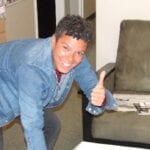Secret Location hides in plain sight on Gastown’s Water Street.
My partner and I stop and stare at its striking white interior, its open and contiguous bar-and-kitchen concept, its funky-chic décor, its chef with a tattooed head, its flitting gay waiter taking the orders of equally gay patrons.
This is the kind of vibe Davie Village could use, I think, about two-and-a-quarter cocktails later.
Gay in a breath-of-fresh-air kind of way. One of the possible next phases after the demise of spaces like the Odyssey, the Jupiter Lounge and its various incarnations, Lick and, now, the impending closure of Rhizome.
To be clear, the operative words are “one of the possible next phases,” not “this is the sole solution to the loss of queer space.”
But in the midst of all the handwringing — in some cases, schadenfreude — over the death or dying throes of gay villages like Davie, Secret Location provides a glimpse of the creative possibilities that were once turned more urgently to the political activism of pushing back against those who pushed us down.
What continues to be a challenge is channelling more of that former mad-as-hell-and-not-taking-it-anymore drive into innovative enterprises that tap into the we’re-also-fucking-innovative-as-hell, by-the-way.
Otherwise, all we are doing is settling.
Settling for the status quo. Settling for being part of, as opposed to standing out and apart. Settling for being invisible in a nebulous mainstream now that we’ve emerged and, to some extent, are still emerging from the invisibility of marginalized existence.
Perhaps that’s what many of us want. But therein lies the problem and the challenge of acceptance and assimilation. To rework a cliché: as we lose the necessity, what need is there of invention — or reinvention?
“We’re all in it for our own personal satisfaction and to have our personal needs met, and very few people now, I think, in the gay men and lesbian community, really have many needs that they think need to be met by a sense of community,” Jim Deva concluded as he reflected on Little Sister’s 30-year odyssey.
Cue the whistling wind and tumbleweed blowing by.
He is right. Partially.
The ways in which — and the reasons why — we came together in protest and solidarity are in large part irrelevant in the 2000s.
Our vocal social-media presence, our increasing visibility in mainstream media, the growing embrace of the sporting world, the momentum behind gay marriage, and the burgeoning number of straight allies mean that we no longer bunker down in segregated enclaves. We almost roll our eyes when celebrities we long suspected were gay decide to come out, especially long after speculation about their sexuality has run its course.
How do we maintain, or create, community when we aren’t immersed in crisis or a fight for our existence? “Is it even important?” Deva wonders.
The reaction to Rhizome’s departure is a clear sign that maintaining shared space and identity is still important to some segments of the community, such as queer folks who are not necessarily involved in queer issues, or see queer issues as part of a greater social-justice movement.
“It does take a handful of people with the gumption, the courage to make it work, so I hope there are people or there is someone who is in a particular place in their lives where they would take something like that up,” community activist Fatima Jaffer says of Rhizome’s imminent departure.
If we want to maintain community, we have to build the spaces, like Secret Location and Rhizome, that match our sense of post-Stonewall, post-decriminalization, post-gay-marriage arrival.
We need to build new, energetic spaces that reflect where we are now, in this moment in time.

 Why you can trust Xtra
Why you can trust Xtra


